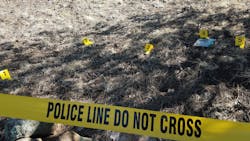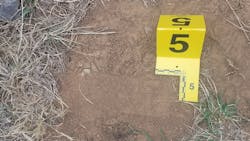No crime scene is ever the same. There may be traces of similarities between one scene and another, but no crime scene is ever exactly alike. Investigators can prepare as much as possible for potential situations such as homicides with multiple victims, scenes without a body and just the evidence, or other “common” situations that are taught in formal crime scene training. However, how do you prepare for those scenes that are out of the ordinary and are not included in basic or intermediate crime scene training?
In-house, investigator-initiated training
Sometimes the best way to prepare for those odd situations is to conduct your own experiments or trainings with mock situations set up. “To prepare for scenes out of the ordinary starts with a solid foundation of knowledge in crime scene disciplines, understanding evidence, preservation, collection and where and how it fits in the overall events of a crime scene,” says Agent Norman Rhoades of the New Mexico State Police Crime Scene Team. “After that, you’ll be able to answer those questions and then focus on how to document, collect and preserve evidence; which each case presents their unique challenges.”
Not sure how you would process a scene that has already been rained on? Practice by taking pieces of “evidence” and spray them with a water bottle. From there, practice the process you would use in order to properly collect the evidence. In a situation such as this, this may mean you need to photograph the evidence as best and as quickly as you can and then let it dry in a contained environment. Meaning, in a clean container or containers so as not to contaminate the evidence but still allowing it to dry.
“It may be specific experts in various fields would have to be called in to assist,” says Rhoades. “One example is a body or other evidence in a mine shaft. Prior to simply entering the mine, considerations need to be thought out such as the possibility of encountering bad air or gases, unstable walls for ceilings, training and equipment for rappelling, etc.” Rhoades says a team of investigators he was with was searching a mine and shaft following a lead regarding a murder victim. The mine extended beyond an area where light could and the area was in total darkness. In addition, the walls and ceilings were unstable. “Prior to entering this mine, mining experts were called who supplemented our gear for safely entering the mine to include lighting resources,” he says. “These mining experts entered first, examined the walls and ceilings and air quality as we continued. We eventually reached a point where large rocks on the ceiling were loose and we stopped there.” The investigators were able to examine the dirt and observe there was no indication of anyone entering the mine recently. “Having the experts in mining with us no doubt saved a potential threat to us.”
Try other simulations including processing specific types of evidence. For example, how would you handle photographing a body that is wedged underneath of a home or in a tight space? You cannot move it until it is photographed and until the death investigator arrives. Take a doll to represent the body and put it in a place that is tight or difficult to get to. From there, take your camera and practice using different techniques in order to get the best photos possible. Of course once the death investigator arrives at a scene and the body may be removed from the location it was found, you could take better photos, but it is equally important to take good, detailed photographs of where the body was found since the position of a body can be very telling as to how and when they died.
How do you lift or reveal prints from glass? Since the standard Amido Black powder does not always reveal latent prints as well on glass, you can use volcanic white fingerprint powder. This type will usually enhance latent prints a little more than regular Amido Black.
Another way you should practice for processing odd evidence or scenes is by practicing your photography with surfaces where an alternative light source (ALS) is needed. Find different substances to place on surfaces and practice. You can either take the photos while the ALS is in place or use filters on your camera. (blue, yellow, green, etc.).Outdoor training
The majority of the time, if you encounter an “odd” crime scene it will most likely be outdoors. Just as mentioned before that no two cases are ever exactly the same, when you add in the elements of the great outdoors, you are bound to run into even more unusual circumstances.
For example, say you have a crime scene that takes place on the beach. You have the following factors to consider: wind, moisture, the tide/water, plant life and animal life. How would you go about processing such a crime scene? For example, bodies that may be in water are another challenge for the crime scene investigator. “Bodies floating in water may entail working with expert police divers,” says Rhoades. “One night we had a body floating in a large pond. We weren’t sure of the depth or drop offs or under current. Although it appeared we could wade to the body, for safety we called in police divers to safely retrieve the body.” Bringing in other experts not only helps preserve the scene better, but will also keep you safe when you encounter odd circumstances.Other odd areas
Other odd places you are going to encounter crime scenes are mountain sides, the desert and those in the rain. It’s always wise to have a plan of action in the event you do encounter an odd crime scene. For instance, if you have a homicide where a body was left on the side of a mountain, how will you process that scene? Put a plan on paper so that if and when you come across that type of situation you are completely prepared.
Let’s delve into that a little more. How would you process a scene, with a body, on a mountain side? Overall, photos are going to be difficult. However, you still need to document it just as you would any other scene. Identifying the exact location of a rural areas with a photo can be a challenge; the landscape could very well look like a lot of other locations. Take photos of your journey up the mountain: street view, base of the mountain, any notable landmarks. This way, when your case goes to court you can document and better articulate where you were and the location of the crime scene. Setting up your evidence markers may be an obstacle as well. If you are unable to take 90 degree or level photos, photograph the evidence as it stands since you must document the exact location where you found the evidence. Once you get the evidence back to your agency, you can always take better closeup photos of the evidence before you complete packaging it. Please note, you should have all evidence separated, labeled and bagged on scene. If you need to take better photographs, ensure that your evidence can be safely transported back to your agency, photograph it, then seal it. If you do this it must also be documented in your report.
The dangers of odd scenes
There will be times where you will encounter dangers at crime scenes, especially if the situation is unusual.
Burned buildings are a type of crime scene that may have potential hazards. “Prior to entering, protective gear should be considered. Helmet, goggles, thick work gloves, heavy boots—similar to fire gear,” says Rhoades. “A crime scene investigator once entered a burned mobile home after it was realized the electrical power was still on. The crime scene investigator had to stand still until utilities arrived to turn the electrical power off.”
Rhoades recalled a scene he worked which presented an unsafe situation while processing a suicide of a lady laying on a bed. “She used an automatic handgun, shot herself in the mouth. Her hand was still on the gun, finger on the trigger, that slid down toward her chest,” says Rhoades. “As we photo documented the body, an investigator was standing on the bed for top overview images. As the bed bounced, so did her trigger finger and the barrel was aimed at the investigator. It wouldn’t take much to discharge the weapon striking the investigator.” Rhoades says the investigator stood still as the handgun was repositioned and removed. The discharge of the weapon had ejected the casing, replacing it with a cartridge. The handgun was in fire mode and ready to shoot again at the squeeze of a finger.
Each of these examples serve as reminders to not only prepare yourself for how to process the scene, but preparing yourself and your team mentally and physically for potential hazards you may encounter.
Practice, practice, practice!
It may feel silly or redundant, but practice processing odd crime scenes. Figure out the best ways to photograph bodies in odd places, or how to collect evidence efficiently. There are classes that offer hands-on “odd” crime scene training. Take advantage of these because they will prepare you for when you encounter that crime scene that makes you think outside of the box. Not only will you know what to do (or who else to call) when you encounter it, but you will be able to remain safe while processing the scene.

Hilary Rodela
Hilary Rodela is currently a Surveillance Officer, a former Private Investigator, a former Crime Scene Investigator, and Evidence Technician. She worked for the Ruidoso (NM) Police Department as well as the Lubbock (TX) Police Department. She has written for several public safety publications and has extensive law enforcement and forensic training and is pursuing forensic expertise in various disciplines. Hilary is a freelance public safety writer and curriculum developer for the National Investigative Training Academy.





